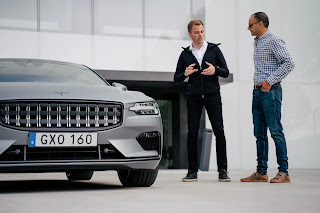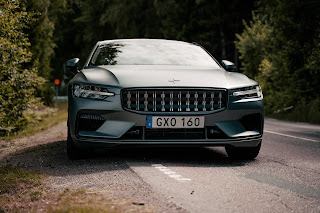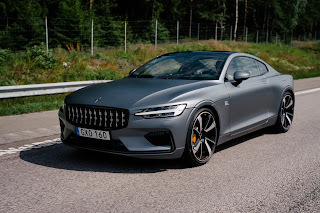GOTHENBURG,
Sweden—A crowd is
gathered at the EV charging station near a tony lakefront lunch spot, their
backs turned to a row of Tesla Model Ss. Despite their conspicuous tints and
matte finishes, the aging EVs pale next to the striking lines of the Polestar 1
prototype, which is
getting the rock-star treatment while it sucks up electrons.
To call the
Polestar 1 a point of Swedish pride would be an understatement of epic
magnitude. But these are complicated times, and the average unsuspecting Swede
is probably also oblivious to the reality that, unlike the 200,000 or so Volvos
produced annually at the nearby factory, the Polestar 1 will be entirely built
in China. It’s a reality that surprises many, perhaps because this big coupe
has a seemingly Continental appearance, including its starkly handsome
silhouette and inscrutably jaunty Nordic curves. Oh, and it doesn’t get any
more Swedish than (Geely-owned) Volvo, does it?
Though
mostly conventional at first glance, there’s a lot of subtle, intriguing
styling touches to beyond the Polestar 1’s stately nose and Hofmeister kink.
The skin’s crisp creases are enabled by the outer layer’s carbon-fiber
construction, which is easier than metal to form sharp edges into. There’s also
a significant amount of carbon beneath the skin as well, although the chassis
is a shortened version of the S90’s SPA platform, which uses more high-strength
steel and aluminum. More notable than its construction, however, is the 1’s
powertrain, a melting pot of motivation that crams a whole bunch of
technologies together to deliver total output of 626 horsepower and 738 lb-ft.
(Non-U.S. cars get stiffed 26 horses due to the stifling effects of the gas
particulate filter.) Up front is Volvo’s S90-sourced 2.0-liter
internal-combustion engine that combines turbocharging and supercharging, aided
by an electric motor at the flywheel and sending its power through an Aisin AW
eight-speed automatic. Motivation at the rear axle is handled by a pair of
individual electric motors, with the system switching between gas,
gas/electric, and pure electric depending on drive modes and/or state of
charge.
Despite the
shock and awe of the future-friendly drivetrain, the cabin is remarkably
understated. Matte carbon-fiber trim and Alcantara meet familiar Volvo
switchgear and screens, with a central, portrait-oriented touchscreen that
manages more then a few of the vehicle’s settings via Volvo’s Sensus interface.
A faceted roller dial on the transmission tunnel—just like the one found in
essentially all modern Volvos—switches between five drive modes: Hybrid (the
default), Pure (good for an estimated 65 miles of electric-only range on the
U.S. test cycle), Power (for the brawniest gas-electric combo), AWD (for snow
and ice), and Individual, which enables customized settings.
The
Drive
Our
prototype drive came with several caveats, as the test car was an early build
with more than a few parameters still being fine tuned. Although the interior
was essentially final production-spec, a large red kill switch sat on the
center console “just in case.” Ominous error messages of largely no material
consequence were on display (“Power Steering Failure” being one) and we were
warned that the drivetrain calibration had a few minor glitches still being
worked out. Fair enough, considering the final-spec cars aren’t due to start
production for another three months.
Pulling out
of Polestar HQ in Hybrid mode made a positive first impression: Between the
smooth tug of EV power, the imperceptible introduction of internal-combustion
thrust, and torque fill from the gas engine’s double-forced induction, there
was none of the unpredictable power surges that plague many hybrids. Keep an
eye on the digital power gauge in the instrument panel, and it’s relatively
easy to maintain decent acceleration without summoning the internal-combustion
engines. Switch to EV-only Pure mode and the twin motors deliver smooth power
accompanied by an audible whir that my copilot, chassis engineer Roger Wallgren,
says will be markedly quieter in final form.
Tap the
crystal shifter once towards you, a tidy little gem manufactured by Orrefors
Sweden, and a stronger engine braking/regen mode is engaged. It’s not quite as
strong as some might prefer and certainly not aggressive enough for true
one-pedal driving, however. In addition, the brake pedal can get grabby below
10 mph, at least in its current configuration. Brake feel from the six-piston
Akebono stoppers is otherwise good at higher speeds. Though pedal feedback is
considerably better than most hybrid systems currently on the market, you won’t
be confusing this with a racecar’s lively brake behavior, and that’s a good
thing, because it remains consistent with the grand tourer’s mission as an
interstate-devouring executive express.
Remarkable
Handling
Though the
steering effort remained constant while toggling through the customizable
settings (possibly related to the indicated error message), the steering’s
weight was on the heavy side but with solid feel. The overall setup felt nicely
sorted, although we would have preferred slightly lower effort—which will
presumably be available when the steering settings are adjustable in production
spec. While driving in Hybrid mode, a long, sweeping highway on ramp revealed a
remarkable trait you’ll find in the similarly configured (but more radically
packaged) Acura NSX and Porsche 918 Spyder: an
ability for the electric motors to vector torque in a way that makes it truly
difficult to overdrive the car.
Squeeze the
right pedal beyond where you typically might, and instead of understeering the
car manages to hunker down into an optimal line. Keep pressing, and the bespoke
Pirelli P Zero rubber on staggered 22-inch wheels hangs on persistently,
despite the massive forces of momentum at play. It’s an impressive defiance of
physics, one that seems highly illogical since this big-boned two-door weighs a
considerable 5,180 pounds. Incidentally, 754 of those pounds consist of battery
packs alone. Aiding maneuverability are weight-saving carbon-fiber upper
structures and the low, rearward positioning of the battery packs.
The
Suspension
Also
anathema to the car’s heft is how well it handles bumps, which can be largely
attributed to the outstanding Öhlins Road & Track suspension system, not to
mention development work done by the likes of Wallgren on test tracks in Sweden
and around the world. Though initially conceived as an automatically adaptive
system, the 1 was eventually switched to use a manually adjustable setup that
requires turning shock dials under the hood to one of 22 positions. Though
Wallgren told us adjusting the rear shocks requires lifting the car on a hoist,
another Polestar source revealed an easier method: pulling the car up onto a
curb and simply reaching between the body and the wheel.
About
halfway through our five-hour test drive, we stopped to adjust the suspension
for a more technical stretch of road, which had been in its default middle
setting. Per Wallgren’s suggestion, we turned the bronze dial at the top of the
shock structure three clockwise clicks, which yielded a noticeably crisper ride
and sharper turn-in without much detriment to ride quality. As hinted at when
we traversed the on ramp, the Polestar 1’s road grip is outstanding and its
handling predominantly flat, with just enough roll to communicate how the
chassis relates with the road.
‘Though not
a razor’s-edge canyon carver, the big coupe acquits itself remarkably well over
Sweden’s rambling country roads, especially when considering its prodigious
curb weight. Power is easily accessible coming out of apexes, and it’s laid
down with excellent body control that only starts to show soft spots during
quick switchbacks that abruptly throw around the car’s mass. Shortly after the
windy stretch, Wallgren opted to switch back to the middle setting, as though
to suggest I might find it too firm for bumpy city roads.
The acute
awareness of suspension compliance reveals much about the Polestar 1’s mission.
Though its 65 or so miles of pure electric power make it ideally suited for
urban commutes, especially in regions where internal-combustion cars are
increasingly faced with congestion charges, Polestar’s debut vehicle also
manages to shine during high-speed highway blasts. On those open stretches of
road, its union of gas and electric power conspire to lend it a sense of
potent, imperturbable presence, with loads of torque and ample passing power.
It’s a
funny thing, that the first car in the new marque’s premium, future-forward
lineup harkens back to such an old-world niche as a grand touring coupe with
commanding front seats and tiny rear perches. There is a certain luxury here,
for sur—and it’s not just about the six-figure price of entry or the
sports-car-worthy horsepower figure. By allocating a total of only 1,500 of
these flagships, just 140 or so which will come the U.S. in the first year,
Polestar is making a bigger statement about its grand plans to build special
cars, even if the Tesla
Model 3-challenging Polestar 2 will be a volume play. Specialness is an excellent place to start.
Let’s hope it’s a feeling that extends to every Polestar.
Source: Automobile Mag.










































Commentaires
Enregistrer un commentaire